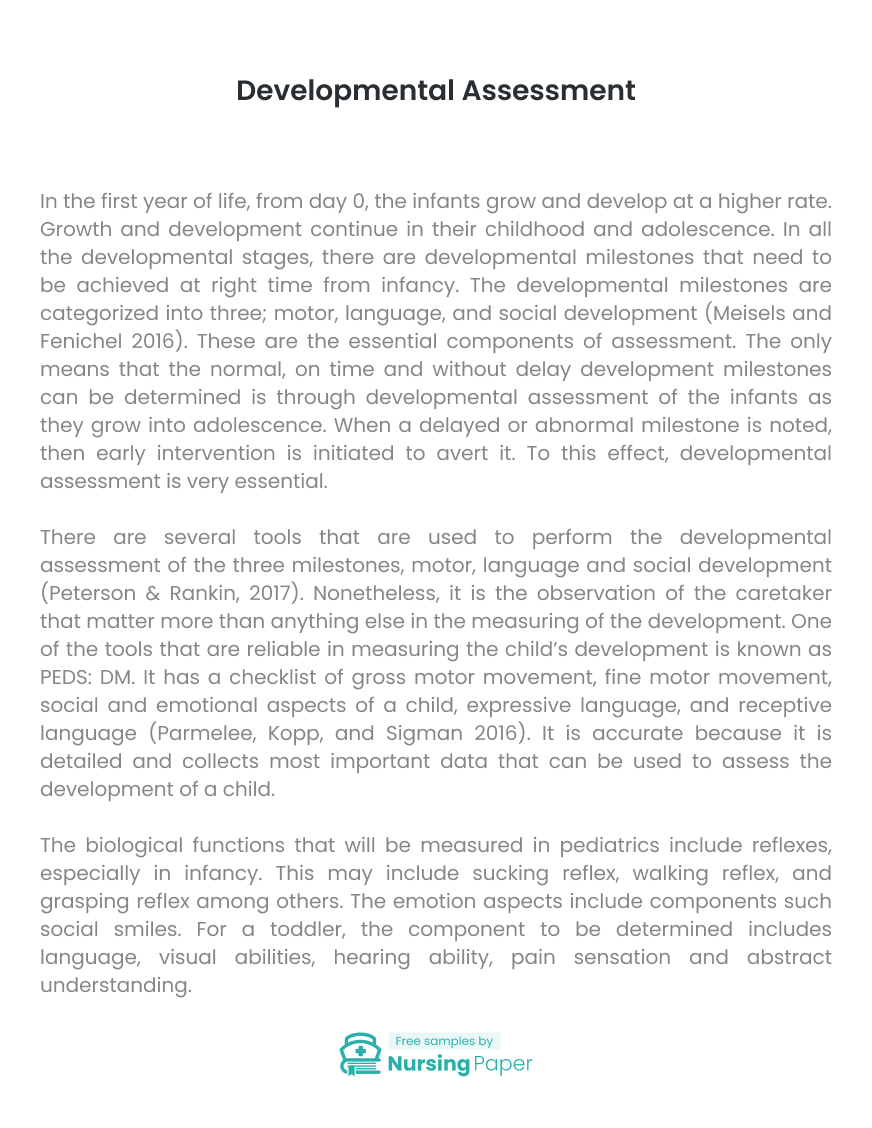
Developmental Assessment
Introduction
In the first year of life, from day 0, the infants grow and develop at a higher rate. Growth and development continue in their childhood and adolescence. In all the developmental stages, there are developmental milestones that need to be achieved at right time from infancy. The developmental milestones are categorized into three; motor, language, and social development (Meisels and Fenichel 2016). These are the essential components of assessment. The only means that the normal, on time and without delay development milestones can be determined is through developmental assessment of the infants as they grow into adolescence. When a delayed or abnormal milestone is noted, then early intervention is initiated to avert it. To this effect, developmental assessment is very essential.
There are several tools that are used to perform the developmental assessment of the three milestones, motor, language and social development (Peterson & Rankin, 2017). Nonetheless, it is the observation of the caretaker that matter more than anything else in the measuring of the development. One of the tools that are reliable in measuring the child’s development is known as PEDS: DM. It has a checklist of gross motor movement, fine motor movement, social and emotional aspects of a child, expressive language, and receptive language (Parmelee, Kopp, and Sigman 2016). It is accurate because it is detailed and collects most important data that can be used to assess the development of a child.


The biological functions that will be measured in pediatrics include reflexes, especially in infancy. This may include sucking reflex, walking reflex, and grasping reflex among others. The emotion aspects include components such social smiles. For a toddler, the component to be determined includes language, visual abilities, hearing ability, pain sensation and abstract understanding. Such components are important to determine. This is because they affect growth (Meisels and Fenichel 2016). A reflex such as sucking determines if the baby can take adequate amount of milk. In case of birth injuries, it may nervous system in the certain region leading to compromised reflexes. The earlier they are determined the better the pediatric patient can be managed.
1. Meisels, Samuel J., and Emily Fenichel (2016) New Visions for the Developmental Assessment of Infants and Young Children. ERIC.
2. Parmelee, Arthur H., Claire B. Kopp, and Marian Sigman (2016) Selection of Developmental Assessment Techniques for Infants at Risk. Merrill-Palmer Quarterly of Behavior and Development 22(3): 177–199.
3. Peterson, L. E., & Rankin, W. (2017). Are Milestones Really Measuring Development?. Journal of Graduate Medical Education, 9(3), 310-312. doi:10.4300/JGME-D-17-00203.1



The download will start shortly.

The download will start shortly.
 Subject:
Health and Social Care
Subject:
Health and Social Care  Number of pages: 4
Number of pages: 4  Subject:
Health and Social Care
Subject:
Health and Social Care  Number of pages: 4
Number of pages: 4  Subject:
Health and Social Care
Subject:
Health and Social Care  Number of pages: 2
Number of pages: 2  Subject:
Nursing
Subject:
Nursing  Number of pages: 2
Number of pages: 2  Subject:
Nursing
Subject:
Nursing  Number of pages: 7
Number of pages: 7  Subject:
Health and Social Care
Subject:
Health and Social Care  Number of pages: 18
Number of pages: 18  Subject:
Health and Social Care
Subject:
Health and Social Care  Number of pages: 12
Number of pages: 12  Subject:
Medicine
Subject:
Medicine  Number of pages: 5
Number of pages: 5  Subject:
Health and Social Care
Subject:
Health and Social Care  Number of pages: 3
Number of pages: 3  Subject:
Medicine
Subject:
Medicine  Number of pages: 11
Number of pages: 11  Subject:
Health and Social Care
Subject:
Health and Social Care  Number of pages: 2
Number of pages: 2  Subject:
Medicine
Subject:
Medicine  Number of pages: 3
Number of pages: 3  Subject:
Health and Social Care
Subject:
Health and Social Care  Number of pages: 2
Number of pages: 2  Subject:
Health and Social Care
Subject:
Health and Social Care  Number of pages: 4
Number of pages: 4  Subject:
Health and Social Care
Subject:
Health and Social Care  Number of pages: 3
Number of pages: 3 
